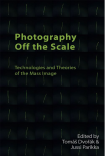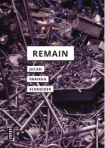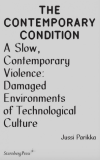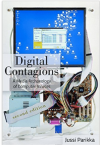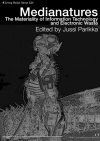Archive
Strelka podcast interview
Posting this earlier (Feb 2020) recorded interview at Strelka institute, Moscow; Geology of Media is a starting point but the discussion ends up in many other areas as well.
“What kind of cultural theory would be adequate for the age of climate disturbances, technological shifts, and large-scale infrastructures? In this episode, Jussi Parikka, a media theorist and author of ‘Geology of Media’, talks about the materiality of media, slow environmental violence, and the way to apply his theory to The Terraforming. Design research program The Terraforming is a three-year (2020–2022) initiative of the Strelka Institute, directed by Benjamin H. Bratton.”
A Natural History of Logistics
Here’s the video of my Strelka / #TheTerraforming keynote, “A Natural History of Logistics”. Thanks to Benjamin Bratton for the introduction to the talk (and the invitation to be part of The Terraforming Faculty). The talk stems from the seminar and the studio brief we did with the group in February in Moscow. While I outline some theoretical ideas for this synthetic (fake!) discipline, the researchers’ responses in February through mini-projects presented astonishingly good ways how the idea was taken forward: some historically grounded, some speculative, some somewhere in between, takes on soil, seabed mining, geomagnetism, tidal cycles, weeds, and more. Also thanks to Abelardo Gil-Fournier for his lecture and other work for the seminar.
And watch here the projects from the first day:
and the 2nd day in full:
The Terraforming final projects
The final projects of the first Terraforming cohort at Strelka Institute are going to be premiered this week Wednesday and Thursday (July 1 and 2) at 7 pm Moscow time. “The work presented will cover a range of topics of space and sci-fi, artificial food and landscapes, geo- and macro-engineering, and range from speculative design proposals, to cinema, to legal frameworks, to practical propositions for intervention.”


I was happy to be part of the Strelka Institute’s programme as a Faculty member. Working with this massively talented and engaged group of researchers was really a joy. In February, we worked with the brief on “Natural History of Logistics” which is somewhat also the topic of my keynote (on Thursday). The other speakers are: Benjamin Bratton, Lisa Messeri, Helen Hester and Kim Stanley Robinson.
A Lab of Labs
AMT was again part of the Istanbul Design Biennial, this time together with Bilkent University (Ankara) hosting a workshop and a panel. We responded to the main theme of School of Schools with our own emphasis: a lab of labs. In other words, working with the Bilkent Media Archaeology Lab (led by Andreas Treske) we organised a two day event that performed a lab in as a method to investigate it as a assemblage of methods, techniques, affordances of the lab in an urban environment and in the context of Istanbul, a city with a long heritage of crafts, workshops, and design irreducible to a sanitized design thinking discourse.
Benefiting from the experience of Ege Berensel and Başak Altın we engaged in workshopping that included 8 mm found footage (home films) and motherboards (as a source of circuit bending and tinkering). While Ebruk Kurbak joined us to talk about her work in textiles, computing and material methodologies in speculative design, and Tuğçe Karatas shared her views as an independent curator, our special surprise guest was the local TV repair shop expert who gave us a two hour crash course into his work and electronics! The lab includes many kinds of expertise.
The workshop was also part of the research for #TheLabBook – online at What is a Media Lab?.
 Andreas Treske’s opening words, together with Björk’s poetic exploration of the television.
Andreas Treske’s opening words, together with Björk’s poetic exploration of the television.
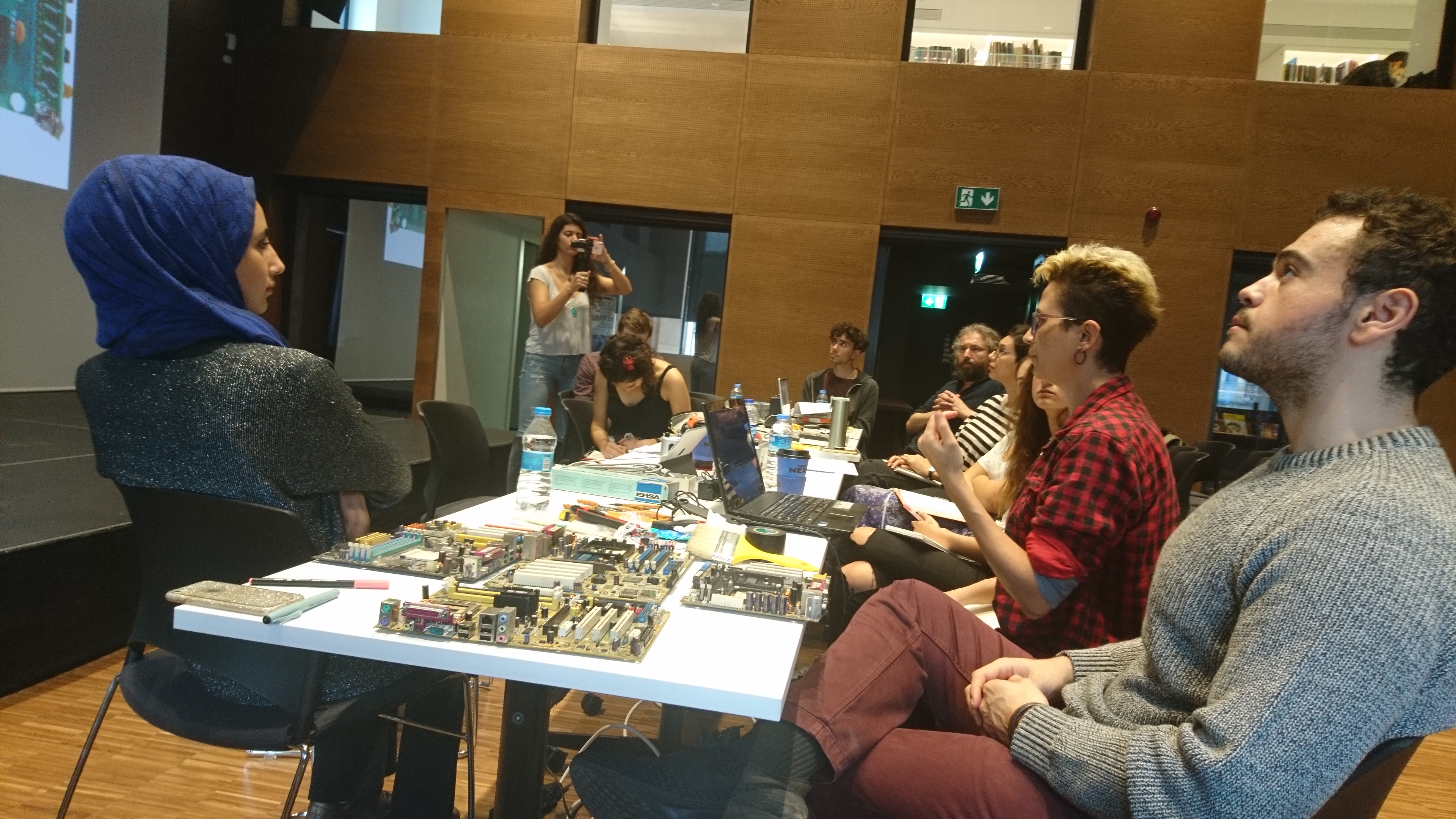 Başak Altın and Ege Berensel, artists from Ankara, were part of the work. Here Basak narrating a short visual history of motherboards.
Başak Altın and Ege Berensel, artists from Ankara, were part of the work. Here Basak narrating a short visual history of motherboards.
 An unpicking of a video projector into its material-epistemic components, measurable as objects of interest, unfolding multiple levels of media archaeology. #OfficeTruisms
An unpicking of a video projector into its material-epistemic components, measurable as objects of interest, unfolding multiple levels of media archaeology. #OfficeTruisms

Labs as hands-on practice.

A short introduction to electronics – from the perspective of repairing televisions and other appliances.
Inventing Pasts and Futures: Speculative Design and Media Archaeology
I wrote a paper some years ago on media archaeology (esp. imaginary media research) and speculative design, to put the two parallel fields in closer dialogue. The text will be featured in a book that is still in preparation and because the first version was written some three-four years ago, I thought at least to add a couple of the first lines online. This is still the version that is not copy edited, but hopefully out one day too! Here’s the start. For the full draft version, please get in touch.
Inventing Pasts and Futures: Speculative Design and Media Archaeology
- Introduction: Imaginary Media as Impossible Yet Necessary Techniques
To be able to start with the non-existent, sometimes even the absurd, is a skill in itself. It can be a methodological way of approaching reality not as ready and finished but produced and open to further variations, potential and a temporality that includes the possibility of something else. Like with all methods, the skill of thinking the non-existent needs practicing. It also needs institutional contexts that are able to support such an odd task that seems devoid of actual truth value and easily dismissed as not incorporating the epistemological seriousness required of the academic subjects. Despite the difficulty of giving a good one-liner definition that could cover all aspects of different traditions of media archaeology, it is safe to say that it has been able to create an identity as a field interested in the speculative. This has meant many things from mobilisation of media history executed by way of surprising connections across art, design, technology and architecture to acknowledging the unacknowledged, a sort of a search and rescue-operation for devices, stories, narratives, uses and misuses left out of the earlier registry. Archaeology has been sometimes used as a general term for the way in which we investigate the conditions of existence of media culture, and the media technical conditions of existence of cultural practices – two things that are closely connected, with the two aspects in co-determining relations: media technology and cultural practices. And it also bends our notions of history and time itself. As Thomas Elsaesser (2016, p. 201) puts it, it is a symptom of a very different sort of a relation to the past: ‘on the one hand, it suggests a freeing up of historical inevitability in favour of a database logic, and on the other hand, it turns the past into a self-service counter for all manner of appropriations.’
Already, early on, imaginary media was one part of the media archaeological body of research. It had the clear aim of reminding scholars and artists that media technological reality was not to be restricted to what actually is. It was not to be contained by the histories of technological achievement but meant to relate to the broader cultural and artistic history, which technology can be imagined, and where it returns as imaginary attachments to values, affects, aspirations and dreams. Eric Kluitenberg (2011) articulates that such shifts are sometimes almost as if seamless, something rather prescient in the marketing discourses of digital culture. We feel constantly even emotionally attached to dream devices of corporations, carefully framed by their sales pitches as part of a wider infrastructure of desire. While such an attachment is odd enough, broadly speaking the discourses of imaginary connections constitute also our cultural topoi (Huhtamo 2011a), which then become the environment for recursive dreaming that characterizes consumer culture and production of reality.
But how boring it would be to restrict oneself to what is actual. A variantology of imaginary media, as Kluitenberg puts it (2011, p. 57) can reach out to theological discourses, aliens and the dead, to things untrue and yet so impactful for any account of cultural history. Such imaginations are ways to rethink the usual coordinates of time and space – the time of not merely a past-that-was, but a past-that-could-have been; a future imagined as one recurring fantasy of rejigging the time we are in now. These are the places that are not only distant but sometimes impossible. How liberating this feels instead of buying into the ready-made dreams. No wonder such strategies can be connected to a wider political imaginary that includes geographical, racialized and gendered others. Artists such as Zoe Beloff have set scenes for alternative media histories through the silent mediums themselves – female protagonists, written into the stories. Kluitenberg points to afrofuturism as one particularly interesting political imaginary. Indeed, as the director John Akomfrah puts it in an interview with Kluitenberg, afrofuturism and other imaginary media practices are not mere mental refuge. They produce and sustain new cultural practices and spaces in which black science fiction carves its own collective existence but also facilitates relations with, for example, gay and women’s movement including in the science fiction of Octavia Butler and Samuel Delaney. What is being approached is a black techno-cultural imagination where also music plays a key role in how pasts, presents, and futures co-determine each other in new ways: ‘Black science-fiction culture, especially music, figures the past in the present by matching the quest for ‘outer’ space with new journals into the inner “technological tape” space of black sound itself via the digital utopias of jungle and techno.’ (Kluitenberg and Akomfrah 2006, p. 293). Even if also imaginary media is at times defined as ‘untimely’ (Zielinski 2006, p. 30; Kluitenberg 2011, p. 56-57), it remains actually an interesting situated practice that is aware of geographies and can challenge the Eurocentric focus of some of the speculative design discourse and practice. Hence, the more interesting of such fabulations actually become ways to imagined situated critiques by way of imaginary. In some recent work, afrofuturism has also been connected to issues of cultural heritage as a project between speculative futures and records of the past (see Nowviskie 2016).
So what does it mean to think of media archaeological and imaginary media projects in the context of speculative design? The question itself acts as a conceptual probe that searches for specific practices in both media and design. Furthermore, it is also a probe that scans the disciplinary relations of two sets of discourses about the past and the future. As two parallel fields with not much contact in the past, speculative design and imaginary media research are interested in how alternative worlds might be created and how temporal, social, and technological fabulations situate coordinates of past-future in alternative ways. I will discuss different art and design projects, cross-fertilising the two traditions of media and design theory and practice, and aim to elaborate ways how media archaeology could contribute to speculative design and to some contemporary issues in critical design. There are some earlier ideas that have suggested how this might work. For example Bruce Sterling’s idea of ‘paleo-futures’ as ‘the reserve of historical ideas, visions and projections of the future—a historical futurity of that prospective’ (Hales 2013, p. 7) is one example of the shared suitably complex time-scales of overlapping design and media archaeological imaginations, but this chapter teases out further contexts for such reserves of historical ideas.
On Disobedient Electronics
Here’s a short manual to what design can – and perhaps often, should – be about: “how to punch Nazis in the face, minus the punching”.

Garnet Hertz’ new critical design zine Disobedient Electronics is a quick and rough, inspiring and useful manual for the Trump, Brexit, post-truth era that needs to address forms of actually working resistance that don’t however merely function only in the realm of already designated possibilities. Hence, throw in a good chunk of speculative design imaginary.
The protest zine is a collection of feminist and other social justice driven projects that carry forward a particular legacy of speculative design that is, in Hertz’s words, slightly less RCA/Dunne & Raby-style than it is confrontational and imaginary in the manner of the Critical Art Ensemble and the Yes Men. The selected projects cut through issues that tell a particular story about North America but also other geographic regions and political realities: issues of gun control and campus carry, gender pay gap, street protest kits, right to abortion, digital privacy and encryption feature centrally. Many of the projects appropriate a seemingly militant form: the Transparency Grenade, the sound cannon in the Device for The Emancipation of the Landscape and the I.E.D. (Improvised Empathetic Device) carry references to forms of violence that are however overturned into devices of creating alternative worlds. Sometimes the devices cross borders such as the Abortion Drone (Women on Waves & Co.) as a particularly inspiring way of diving into the issues of women’s rights across what is far from a unified political space of Europe.
The style of design proposed through the zine and the projects leads the reader to think of Brian Massumi’s ontopower: “a power that makes things come to be: that moves a futurity felt in the present, into a presence in the future.” This sort of a stance to design is useful as well as speaks to the sort of experiments Disobedient Electronics employs. And the projects that are featured are in many cases experiments in their own right – not only in terms of a device that is pitched and presented but as experiments in collective forms, imaginaries and situations. In many ways, you can observe how this fits in with the wider context of Hertz’ own work and The Studio for Critical Making at Emily Carr University of Art and Design, which he describes as a lab of sorts that combines research, humanities and building in ways that results in “technology that is more culturally relevant, socially engaged, and personalized.” Disobedient Electronics is a good example of such work that the project supports both in the space of the studio and in the context of wider discussions about the role of speculative critical practice.
The Residual Media Depot summer school
I had the pleasure of being one of the participants in the Media Archaeology summer school in Montreal at the Residual Media Depot (Concordia). Invited by Darren Wershler, and teaching alongside also Lori Emerson, we had a wonderful group of participants from Canada, Finland, USA, UK and Spain whose own projects and their work at the Depot during the week demonstrated a fantastically broad spectrum of what media archaeology can perform.

I could not emphasise the word perform enough: while we engaged with the theoretical limits and limitations of theoretical work in and around media archaeology, including how it interfaces with for example infrastructure studies, the various probes the students presented and the hands-on work in the Depot investigated the idea of collections as part of the methodology. The performative aspect of media archaeology – and theory broadly speaking – allows to both see it as a situated practice that benefits from its access to institutions and collections as well as creates the space for such to exist: to imagine a media archaeology lab or a collection becomes also a projective way of engaging with the current themes of reshifting humanities infrastructure and institutional changes. As Wershler and Lori Emerson, the director of the Media Archaeology Lab at Boulder, Colorado, also underlined, it is through the particular materiality and access to collections that one can think differently in relation to what are often deemed objects of (media) cultural heritage.

Relating the course’s themes to also his own research, Wershler explained how his interest in the cultural life of signals builds on work in the Depot too. To engage in the work of assembly through old but still functioning systems one is led to understand the various ways the life of signals is constantly constructed and re-constructed across multiple fields of agency from hobbyists to the mini-industry building the various technological tools for an afterlife of for example consoles.
Media archaeology embodies multiple temporalities. The different theoretical frameworks from Erkki Huhtamo to Siegfried Zielinski to Wolfgang Ernst are different solutions to the problem of time – how to approach time differently in methodological ways and in ways that understand technical temporality. For example, Ernst’s ways of approaching time criticality and temporal operationality are something that both offer a different ontological take on technology and also can act as interesting guides in how we work with collections such as the Depot.
In my view, the Residual Media Depot was a perfect platform for the workshop. Wershler had designed the week as a mix of theoretical investigations, student probes and practice-based work that functioned somewhere between maker methodologies, art practices and an archival interest in collections that are important for media theory too. The collection is focused on cultures and technologies of gaming with a special focus on consoles, but as Wershler emphasises, it is not a game archaeology depot. The consoles and the material around them is an entry point to media history and signal culture.

In several ways, the Depot’s work aligns nicely with the Media Archaeology Lab but also with our AMT group: to establish a framework and an enabling situation for a research-teaching continuum that is interested as much in practice-based work as it is in explicating what practices of theory are. All of this feeds also as part of the Lab Book we are writing together.
You can find more information about the Depot on their website and on the same site you can find all the student probes from our week of Media Archaeology.
The Residual Media Depot (RMD) is a project of the Media History Research Centre in the Milieux Institute at Concordia University.

After Arikan: Data Asymmetry
After our succesful exhibition of Burak Arikan’s work, Data Asymmetry, I am posting some of the interviews and material that came out of the exhibition.
Here’s a video interview we did with Arikan setting up the exhibition in the Winchester gallery in November 2016:
And then there’s the interview(s) in Furtherfield: Carleigh Morgan interviewed Burak in the part 1 of the interview about Data Asymmetry and myself in part 2 of the interview. The interview(s) address mapping as a collective experiment, networks as events, (art) methodologies of working with data and a lot of other topics related to internet culture.
What is AMT? A video and an interview
In this video, myself and Ryan Bishop talk a bit more about what the new research group (or office) Archaeologies of Media and Technology does and how it sits as part of the research and practice at Winchester School of Art.
In addition, a new interview with me (conducted by Thais Aragão) is now online and available in English and in Portuguese. The interview is focused on AMT as a platform for practice and theory and how it connects to themes in media archaeology and digital culture research.
You can find AMT online at: http://www.southampton.ac.uk/amt/
and on Twitter at @amt_office
Data Asymmetry – a Burak Arikan exhibition in Winchester
 I am happy to announce that the Turkish artist, technologist Burak Arikan’s exhibition Data Asymmetry opens in November at the Winchester Gallery (at the Winchester School of Art).
I am happy to announce that the Turkish artist, technologist Burak Arikan’s exhibition Data Asymmetry opens in November at the Winchester Gallery (at the Winchester School of Art).
The exhibition addresses critical mapping as a way to understand data culture. The pieces raise questions about the predictability of ordinary human behavior with MyPocket (2008); revealing insights into the infrastructure of megacities like Istanbul as a network of mosques, republican monuments and shopping malls (Islam, Republic, Neoliberalism, 2012) ; remapping and organising recurring patterns in the official tourism commercials of governments with Monovacation (2012); exploring the growth of networks via visual and kinetic abstraction with Tense Series (2007-2012); and showcasing collective production of network maps from the Graph Commons platform. As the works emphasise, the aim of the Graph Commons is to empower people and projects through using network mapping, and collectively experiment with mapping as an ongoing practice.
Previously Arikan has had his work shown at venues such as the Museum of Modern Art New York, Venice Architecture Biennale, São Paulo Biennial, Istanbul Biennial, Berlin Biennial, Ars Electronica and many others.
The exhibition opens November 10.
In addition to the exhibition in the Winchester gallery, Arikan is organising a workshop on critical mapping and network graphs at the Winchester School of Art.
Arikan’s visit also includes another workshop in London at the British Library and as part of the Internet of Cultural Things-project. The visit to Winchester is also supported by the AMT research group at WSA.
For more context on Arikan’s art practice, please find here an audio interview I did with Arikan on stage at transmediale 2016 in Berlin.
For information and queries, please contact me: Contact details.


